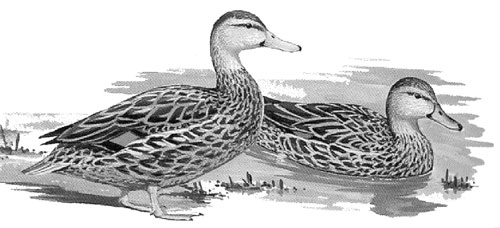 |
10% off on
web orders over $100 |
|
|

|
|
Environmental groups support plan to protect unique duck sub-species
Federal and state wildlife officials are cooperating in an effort to preserve the genetic purity of Florida’s mottled ducks – a subspecies that occurs nowhere else in the world.
The U.S. Fish and Wildlife Service accepted public comments through August 30, 2002, on a draft environmental assessment of a proposal to grant the Florida Fish and Wildlife Conservation Commission (FWC) permits to remove artificially introduced mallards from state waters where mallards mix with mottled ducks.
 “The permit would be part of a comprehensive effort by the FWS and FWC to conserve mottled ducks through scientific management and public awareness.” said Sam D. Hamilton Southeast Regional Director of the U.S. Fish and Wildlife Service. “The permit would be part of a comprehensive effort by the FWS and FWC to conserve mottled ducks through scientific management and public awareness.” said Sam D. Hamilton Southeast Regional Director of the U.S. Fish and Wildlife Service.
To ensure the FWC and permitted trappers remove only artificially introduced mallards; the permits would be valid May through August. Wild mallards are migratory, and few of them are present in Florida during that period. Artificially introduced mallards, however, do not migrate and sometimes pair up with mottled ducks during mating season.
“The state and federal wildlife agencies have our complete support in this project,” said Dr. Paul Gray of Audubon of Florida. “Florida’s mottled ducks are unique, and we could lose the whole sub-species if we don’t stop them from breeding with mallards.”
As another part of their mottled duck conservation plan, the FWC is undertaking a public education and communication plan to promote citizen understanding and support for the mottled duck preservation effort. Officials believe most of the offending mallards are ducks that owners may have released (which is illegal in Florida) or who otherwise escaped captivity.
“The key to success of this effort is to educate the public so they know artificially released mallards are an environmental threat to mottled ducks,” said Kevin Hall, president of United Waterfowlers of Florida. “This is a problem that will require a comprehensive solution. It will require people-management as well as wildlife management.”
State and federal wildlife agencies have not expressed opposition to ownership of mallards, but emphasize that owning a mallard requires a 10-year commitment to be diligent about keeping the mallard away from wild ducks.
“This whole issue illustrates the complexities of preserving Florida’s living resources,” said Dr. Franklin Percival, leader of the Florida Cooperative Fish and Wildlife Research Unit at the University of Florida. “It takes partnerships between government agencies and concerned citizens. That’s the only way we can ensure that unique species like Florida’s mottled ducks will be around for future generations to enjoy. The FWS and FWC are doing what has to be done, and they have our support on this issue.”
If the FWS issues the permit to remove mallards during non-hunting seasons, as proposed in the EA, removal will be limited to public waters and private waters where landowners offer the FWC and its permit holders access. Removal can involve lethal and non-lethal means. In many cases, the non-migratory mallards reside in urban ponds where trapping is the most practical removal option.
FWS officials said an open hunting season on mallards during the May – August period is not an option for reducing the crossbreeding problem because of the locations of the mallards and the fact that hunting seasons are structured to maintain wildlife population levels. The objective of the mallard removal permit, on the other hand, would be to reduce the population of non-migratory, free-ranging mallards in areas where mallards are causing problems. |
 Back | News Page
Back | News Page
|



















